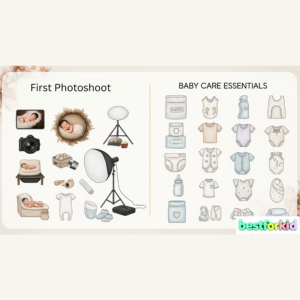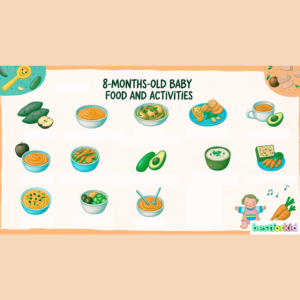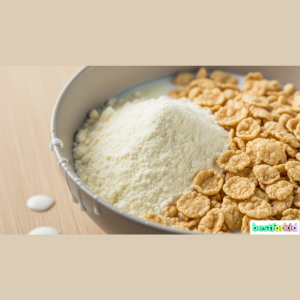
Welcome to the wonderfully dynamic world of being a parent to an eight-month-old! This is a magical time filled with rapid growth, newfound mobility, and a whole lot of personality. As your little one transitions from gentle cuddles to determined crawling, their nutritional needs and desire for engagement are also evolving. This guide is here to walk you through everything you need to know about 8-month baby food, from creating a balanced diet chart to planning fun, developmental activities. We’ll explore delicious and easy-to-make recipes tailored for an Indian palate, ensuring your baby gets the best start in their culinary journey. So, let’s embark on this exciting chapter together and discover how to best nourish your growing baby.
The Exciting World of Your 8-Month-Old: Milestones to Watch For
At eight months, your baby is no longer a passive observer. They are an active participant in their world, learning and growing at an incredible pace. Understanding their developmental milestones is key to providing the right kind of support and stimulation, especially when it comes to their diet and daily activities. Every baby develops at their own pace, but here are some common milestones you might observe.
Gross Motor Skills: Gearing Up for Mobility
This is a major area of development for your eight-month-old. You’ll likely notice a significant increase in their movement and coordination. Many babies at this age can sit independently without support for extended periods. This newfound stability frees up their hands to explore toys and, eventually, food. The precursor to walking, crawling, often begins around this time. Some babies will do the classic hands-and-knees crawl, while others might opt for a “scoot” on their bottom or a “commando crawl” on their belly. All of these are perfectly normal ways for your baby to start exploring their environment. You might also see them pulling themselves up to a standing position using furniture for support. This is a thrilling, albeit slightly nerve-wracking, development for parents!
Fine Motor Skills: The Pincer Grasp and Self-Feeding
While their large muscles are getting a workout, their smaller muscles are also becoming more refined. A significant development at this age is the emergence of the pincer grasp – the ability to pick up small objects between their thumb and forefinger. This is a crucial skill for self-feeding. You’ll notice them trying to pick up small pieces of food, which is a great sign that they are ready to try some finger foods. They are also getting better at moving objects from one hand to the other and bringing things to their mouth for exploration.
Cognitive and Language Development: Babbling and Understanding
Your baby’s brain is buzzing with activity. They are beginning to understand the concept of object permanence – the idea that things still exist even when they can’t see them. This is why games like peek-a-boo are so entertaining for them now. Their babbling is also becoming more complex, and you might hear them stringing together consonant and vowel sounds, like “ma-ma” or “da-da”. While they may not yet attach meaning to these words, they are practicing the sounds and rhythms of speech. They are also starting to recognize their own name and may turn their head when you call them.
Social and Emotional Growth: Stranger Anxiety and Stronger Bonds
As your baby’s memory and awareness grow, so do their emotional responses. It’s common for eight-month-olds to develop separation anxiety and a fear of strangers. This is a normal part of their development as they form strong attachments to their primary caregivers. They are becoming more expressive with their emotions and can often read and respond to your facial expressions. They are learning to communicate their needs and wants through a combination of sounds, gestures, and facial expressions.
Nutritional Needs: Fueling Your 8-Month-Old's Growth
With all this growing and moving, your eight-month-old needs the right fuel to power their development. While solid foods are becoming a more significant part of their diet, it’s important to remember that their primary source of nutrition still comes from breast milk or formula. A balanced intake of calories and key nutrients is essential for their physical and cognitive growth.
The Continued Importance of Breast Milk or Formula
For the first year of life, breast milk or formula should be the main component of your baby’s diet. It provides the perfect balance of fats, proteins, and carbohydrates, along with essential vitamins and minerals. At eight months, your baby will likely be having around 4-5 milk feeds a day. It’s generally recommended to offer breast milk or formula before solid food meals to ensure they are getting their primary source of nutrition first.
Caloric Needs for an Active Baby
An eight-month-old baby needs approximately 750 to 900 calories per day. About 400 to 500 of these calories should come from breast milk or formula, which is equivalent to about 720 ml. The remaining calories will come from the solid foods you introduce. As your baby becomes more active, their caloric needs will increase. It’s important to offer a variety of nutrient-dense foods to meet these demands.
Key Nutrients for Development
Certain nutrients are particularly crucial at this stage of development. Iron is vital for brain development and preventing anemia. Good sources include iron-fortified baby cereals, lean meats like chicken, and legumes such as lentils. Zinc supports a healthy immune system and overall growth. It can be found in meat, beans, and whole-milk yogurt. Calcium is essential for building strong bones and teeth. Dairy products like yogurt and cheese, as well as leafy greens like spinach, are excellent sources. Vitamin A is important for vision, immune function, and skin health. Carrots, sweet potatoes, and mangoes are rich in this vitamin. Vitamin D works with calcium to build strong bones. While some foods contain vitamin D, sunlight is the primary source. However, since babies should be protected from direct sun, your pediatrician may recommend a supplement.
Crafting the Perfect 8-Month Baby Food Chart: An Indian Perspective
Creating a food chart for your eight-month-old can feel like a big task, but it’s also an exciting opportunity to introduce them to a world of flavors and textures. For an Indian household, the options are vast and incredibly nutritious. Here’s a guide to help you plan your baby’s meals with an Indian touch.
What Can My 8-Month-Old Eat? A Comprehensive Food List
At eight months, you can expand the variety of foods you offer your baby. Here’s a list of foods suitable for this age, keeping the Indian context in mind:
- Fruits: Apple, Banana, Pear, Papaya, Mango, Chikoo (Sapodilla), Peaches, Plums, Blueberries, Dates, Figs. These can be offered as purees, mashes, or soft, small pieces for finger feeding.
- Vegetables: Sweet Potato, Potato, Carrot, Beetroot, Pumpkin, Bottle Gourd (Lauki), Peas, Broccoli, Cauliflower, Spinach. All vegetables should be well-cooked and mashed or cut into soft, manageable pieces.
- Cereals & Grains: Rice, Ragi (Finger Millet), Suji (Semolina), Oats, Dalia (Broken Wheat). These can be made into porridges or kheer.
- Pulses: Moong Dal (Yellow Lentil), Masoor Dal (Red Lentil), Toor Dal (Pigeon Pea). Dals should be cooked until very soft and can be given as a soup or mixed with rice to make khichdi.
- Dairy: Curd (Yogurt), Paneer (Indian Cottage Cheese), Ghee (Clarified Butter), Butter. Ensure dairy products are pasteurized.
- Non-Vegetarian: Egg yolk and well-cooked, pureed or minced chicken or fish can be introduced.
Sample Weekly 8-Month Baby Food Chart
Here is a sample food chart to give you an idea of how to structure your baby’s meals for a week. Remember, this is just a guideline, and you should always follow your baby’s cues for hunger and fullness.
| Day | Breakfast (8:00 AM) | Mid-Morning (11:00 AM) | Lunch (1:00 PM) | Evening Snack (4:00 PM) | Dinner (7:00 PM) |
|---|---|---|---|---|---|
| Monday | Suji Upma | Mashed Banana | Moong Dal Khichdi | Apple Puree | Vegetable Soup |
| Tuesday | Ragi Porridge | Yogurt | Rice with Mashed Pumpkin | Pear Slices (steamed) | Oats Porridge |
| Wednesday | Oats Kheer | Mashed Papaya | Dalia with Vegetables | Paneer Cubes (soft) | Carrot and Beetroot Soup |
| Thursday | Mashed Potato with a little Ghee | Chikoo Puree | Rice with Masoor Dal | Yogurt | Suji Porridge |
| Friday | Apple Ragi Porridge | Mashed Mango (seasonal) | Vegetable Khichdi | Steamed Carrot Sticks | Tomato Soup |
| Saturday | Suji Kheer | Mashed Avocado | Rice with Spinach Puree | Boiled Sweet Potato Cubes | Moong Dal Soup |
| Sunday | Oats Upma | Banana and Yogurt Mash | Paneer and Pea Pulao (mashed) | Soft Pear Chunks | Mixed Vegetable Puree |
Food Textures: Moving Beyond Purees
At eight months, you can start moving away from thin purees and introducing more texture to your baby’s food. This is crucial for developing their chewing skills and preparing them for family meals. Start by making purees thicker. Then, progress to mashing foods with a fork instead of blending them, leaving some small, soft lumps. Soft mashed foods like avocado, banana, and well-cooked sweet potato are great for this stage. You can also introduce hard munchables like a large piece of carrot (too big to be a choking hazard) for them to gnaw on, which helps with jaw development. As they get more comfortable, you can offer soft, diced, or grated foods.
Introducing Spices to Your Baby’s Diet
Indian cuisine is known for its aromatic spices, and you might be wondering when you can introduce these flavors to your baby. It’s generally recommended to wait until your baby is around eight months old before adding mild spices to their food. This helps to prevent any potential stomach upset or allergic reactions. You can start with a tiny pinch of spices like turmeric (haldi), cumin (jeera), coriander (dhania), asafoetida (hing), and cinnamon (dalchini). These not only add flavor but also have digestive benefits. Avoid hot spices like chili and garam masala until your baby is older. Always introduce one new spice at a time and wait a few days to watch for any reactions.
Delicious and Nutritious 8-Month Baby Food Recipes
Preparing homemade baby food is a wonderful way to ensure your little one gets fresh, wholesome meals. Here are some simple and nutritious recipes perfect for your eight-month-old, with a focus on Indian flavors.
Breakfast Boosters
Suji Upma: A soft and easy-to-digest breakfast option. Dry roast a few tablespoons of suji (semolina) until fragrant. In a separate pan, heat a little ghee and add a pinch of mustard seeds (optional). Once they splutter, add finely chopped vegetables like carrots and peas and sauté until soft. Add water and a pinch of salt (optional, for babies over one year). When the water boils, slowly add the roasted suji, stirring continuously to avoid lumps. Cook until the suji has absorbed the water and is soft. You can add more water to achieve a porridge-like consistency.
Ragi Porridge: Ragi is a powerhouse of calcium and iron. Mix a tablespoon of ragi flour with a little water to form a smooth paste. In a pan, bring about a cup of water to a boil. Slowly add the ragi paste, stirring constantly. Cook for a few minutes until the ragi is cooked and the porridge has thickened. You can sweeten it with a little fruit puree like apple or banana.
Wholesome Lunch and Dinner Ideas
Moong Dal Khichdi: This is a classic Indian baby food for a reason. It’s gentle on the stomach and provides a good balance of carbohydrates and protein. Wash a tablespoon each of rice and moong dal. In a pressure cooker, heat a little ghee and add a pinch of cumin seeds and turmeric powder. Add the rice and dal, along with finely chopped vegetables like carrots or bottle gourd. Add enough water, and pressure cook until everything is very soft and mushy. Mash well before serving.
Vegetable Pulao: A flavorful and nutritious one-pot meal. In a pressure cooker, heat some ghee. Sauté finely chopped onions until soft. Add ginger-garlic paste (a tiny amount) and then finely chopped vegetables like peas, carrots, and beans. Add washed rice and enough water. Pressure cook until the rice and vegetables are well-cooked. Mash it to a suitable consistency for your baby.
Paneer Mash: Paneer is an excellent source of protein and calcium. Crumble a small piece of fresh paneer. You can lightly sauté it in a little ghee with a pinch of cumin powder. Mash it well and serve. You can also mix it with mashed vegetables like peas or carrots.
Fun with Finger Foods
Steamed Vegetable Sticks: Carrots, sweet potatoes, broccoli florets, and beans can be steamed until soft and cut into finger-sized sticks. These are easy for your baby to hold and munch on.
Soft Fruit Pieces: Ripe banana, chikoo, papaya, and mango can be cut into small, bite-sized pieces. Ensure there are no seeds or hard skin.
Paneer Cubes: Soft paneer can be cut into small cubes for your baby to practice their pincer grasp. You can lightly sauté them in ghee for added flavor.
Beyond the High Chair: Engaging Activities for Your 8-Month-Old
Your eight-month-old’s development isn’t just about food. Play is crucial for their learning and growth. Engaging in simple, age-appropriate activities can do wonders for their physical and cognitive skills.
Activities to Boost Gross Motor Skills
Create a Safe Crawling Zone: Clear a space on the floor and make it safe for your baby to explore. You can place toys just out of their reach to encourage them to move towards them. Creating an obstacle course with pillows and cushions can make crawling more fun and challenging.
Encourage Pulling Up: Place sturdy, low furniture in their play area where they can safely practice pulling themselves up to a standing position. Always supervise them during this activity.
Fine-Tuning Fine Motor Skills
Stacking and Toppling: Stacking blocks or even plastic cups is a great activity for developing hand-eye coordination and understanding cause and effect. They will probably enjoy knocking the tower down more than building it up!
Sensory Play: Create sensory bags by sealing different textured items like cooked pasta or squishy toys in a zip-lock bag. This allows them to explore textures without the mess. Water play in a shallow tub with floating toys is also a big hit at this age.
Stimulating Cognitive Growth
Peek-a-Boo and Hide-and-Seek: These classic games are perfect for reinforcing the concept of object permanence. You can hide a toy under a blanket and encourage them to find it.
Reading Books: It’s never too early to start reading to your baby. Choose board books with large, colorful pictures and interesting textures. Point to the pictures and name the objects to build their vocabulary.
Encouraging Language Development
Talk and Sing: Talk to your baby throughout the day, describing what you are doing. Sing nursery rhymes and make funny sounds. This helps them learn the rhythm and patterns of language.
Imitate Their Babbles: When your baby babbles, imitate their sounds back to them. This shows them that you are listening and encourages them to “talk” more.
A Day in the Life: Sample Schedule for an 8-Month-Old
Having a routine can bring a sense of predictability and security for your baby. Here’s a sample schedule that balances meals, naps, and playtime. Remember that this is just a template, and you should adapt it to your baby’s individual needs and cues.
- 7:00 AM: Wake up and breastfeed or formula feed.
- 8:00 AM: Breakfast (e.g., Ragi porridge).
- 9:00 AM – 10:30 AM: Nap time.
- 10:30 AM – 12:00 PM: Playtime (e.g., crawling practice, stacking blocks).
- 12:00 PM: Breastfeed or formula feed.
- 1:00 PM: Lunch (e.g., Moong dal khichdi).
- 1:30 PM – 3:00 PM: Playtime (e.g., reading books, sensory play).
- 3:00 PM – 4:30 PM: Nap time.
- 4:30 PM: Evening snack (e.g., mashed fruit or yogurt).
- 5:00 PM – 6:30 PM: Playtime (e.g., a walk outside, playing with musical toys).
- 6:30 PM: Breastfeed or formula feed.
- 7:30 PM: Dinner (e.g., vegetable soup).
- 8:00 PM: Bedtime routine (e.g., a warm bath, cuddles, a lullaby).
- 8:30 PM: Bedtime.
Most eight-month-olds need about 11-12 hours of sleep at night and 2-3 hours during the day, split between two or three naps.
Common Concerns and Feeding Tips for Parents
Introducing solids can come with its own set of questions and challenges. Here are some common concerns and tips to help you navigate this phase smoothly.
Dealing with Fussy Eaters
It’s completely normal for babies to be hesitant about trying new foods. They might refuse a new food several times before accepting it. It can take up to 8-15 tries for a baby to accept a new food, so don’t be discouraged. Try offering the food again in a few days. Also, make mealtimes a positive and relaxed experience. Avoid forcing your baby to eat, as this can create negative associations with food.
Gagging vs. Choking: Knowing the Difference
Gagging is a natural reflex that helps prevent choking. When a baby gags, they might cough, and their eyes may water. It’s a sign that they are learning to manage different food textures in their mouth. Choking, on the other hand, is silent and much more serious. A choking baby may not be able to make any sound or breathe. It’s crucial to know the difference and to be prepared for both. Always supervise your baby during mealtimes and ensure that finger foods are soft and cut into appropriate sizes.
Food Allergies: What to Watch For
When introducing new foods, it’s important to watch for signs of an allergic reaction. Introduce only one new food at a time and wait for three to five days before introducing another. Common allergenic foods include eggs, milk products, soy, wheat, peanuts, and fish. Signs of an allergic reaction can include a rash or hives, swelling of the face or lips, vomiting, diarrhea, or difficulty breathing. If you suspect an allergic reaction, contact your pediatrician immediately.
Essential Feeding Tips for Success
- Create a Positive Mealtime Environment: Make mealtimes a happy and social time. Sit with your baby while they eat and talk to them.
- Encourage Self-Feeding: Let your baby get messy! Allowing them to touch and play with their food is part of the learning process. It helps them become more comfortable with different textures and encourages independence.
- Offer Variety: Introduce a wide range of flavors and textures to help develop your baby’s palate.
- Trust Your Baby’s Cues: Your baby will let you know when they are hungry and when they are full. Don’t force them to finish everything on their plate.
- Stay Hydrated: Offer sips of cooled, boiled water with meals.
For more detailed information, you can also visit official government resources like RCH Portal, POSHAN Abhiyaan, and the National Health Mission Immunization Page.
Frequently Asked Questions (FAQ)
How many meals should an 8-month-old have?
An 8-month-old should typically have two to three solid food meals a day, along with one or two snacks. Breast milk or formula remains their primary source of nutrition.
Is it okay to add salt or sugar to my 8-month-old’s food?
It is generally recommended to avoid adding salt and sugar to your baby’s food. Their kidneys are still developing and cannot handle too much salt. Sugar is unnecessary and can lead to a preference for sweet foods.
When can I introduce egg to my 8-month-old?
You can introduce the egg yolk to your baby at eight months. It’s a good source of iron and choline. Egg whites are more likely to cause an allergic reaction, so it’s often recommended to wait until after the first birthday to introduce them. However, recent research suggests that early introduction of allergenic foods may help prevent allergies. It’s best to discuss this with your pediatrician.
My 8-month-old has no teeth yet. Can they eat finger foods?
Yes, absolutely! Babies don’t need teeth to eat soft finger foods. Their gums are quite strong and can mash soft foods effectively. Ensure that the finger foods you offer are soft enough to be easily mashed between your fingers.
You May Also Like

2025’s Best Baby Diapers in India Every Parent Should Know
Finding the right diaper can be a game-changer for both parents and babies. In this guide, we’ve rounded up the best baby diapers in India for 2025 that offer superior comfort, absorbency, and skin protection. Whether you’re looking for budget-friendly options or premium brands, this list helps you make the right choice for your little one’s needs.
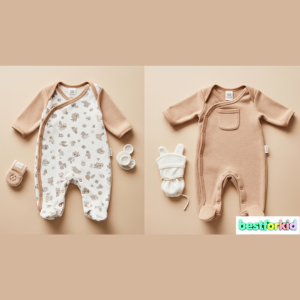
Newborn Clothing Made Easy: Comfort Meets Practicality
Dressing your newborn doesn’t have to be complicated. This guide simplifies your shopping by focusing on clothes that are soft, breathable, and easy to wear. Discover top picks for rompers, onesies, and sleepwear that combine comfort with convenience—perfect for your baby’s delicate skin and your daily routine.
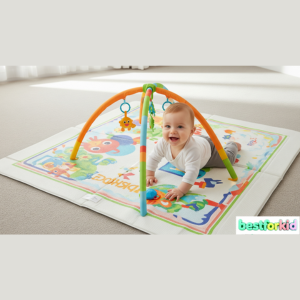
10 Best Baby Play Mats for Comfort, Safety & Entertainment
A good play mat offers more than just a soft surface—it encourages sensory development, tummy time, and safe play. We’ve curated the best baby play mats of 2025 that tick all the boxes: comfort, safety, durability, and design. Explore options that turn your floor into a fun and nurturing environment for your baby.

